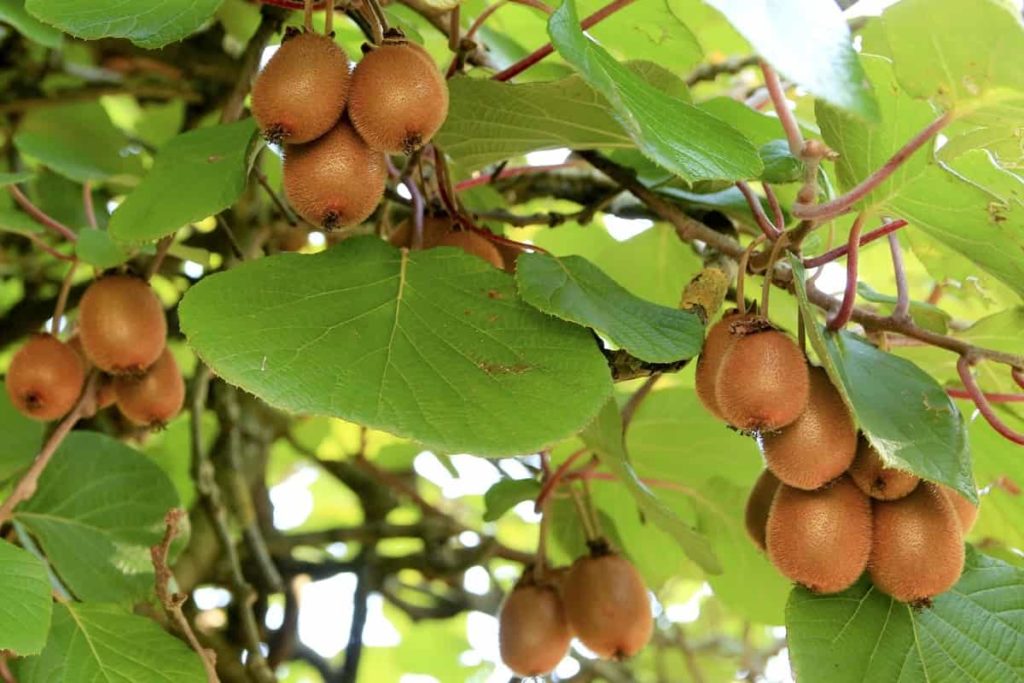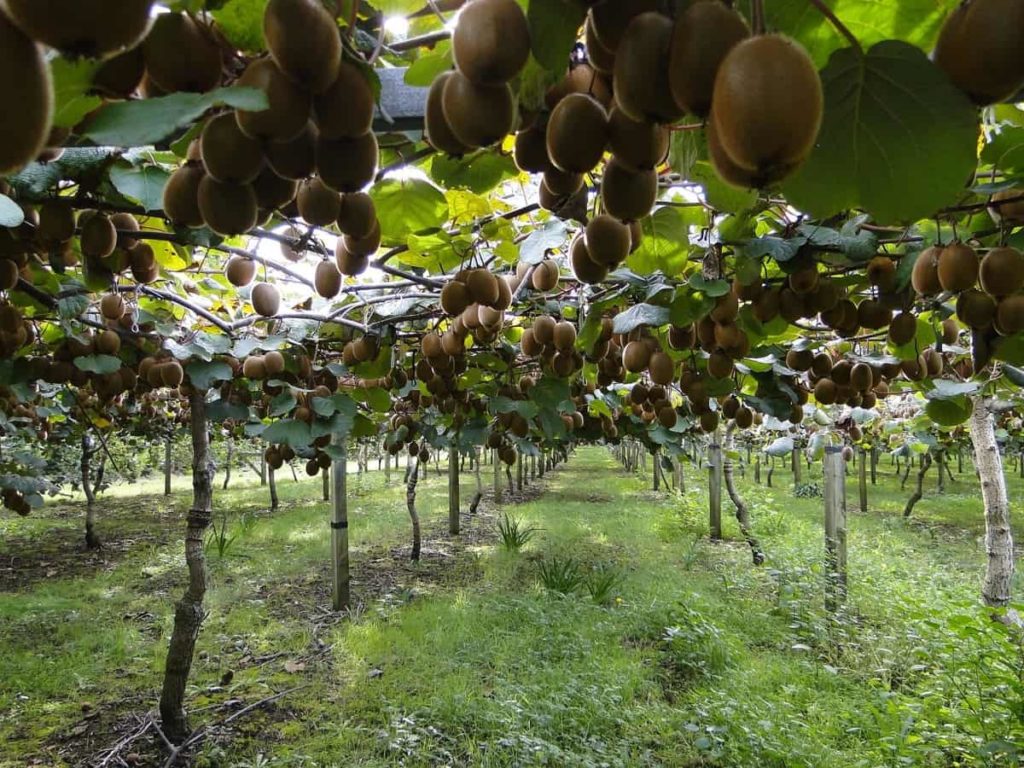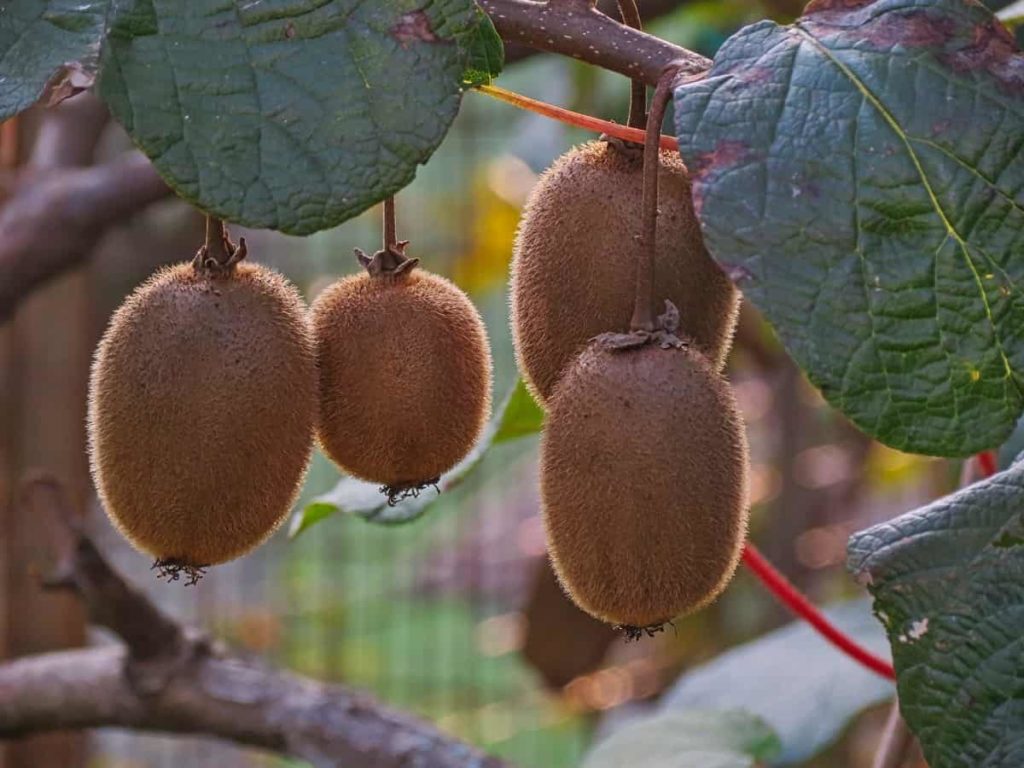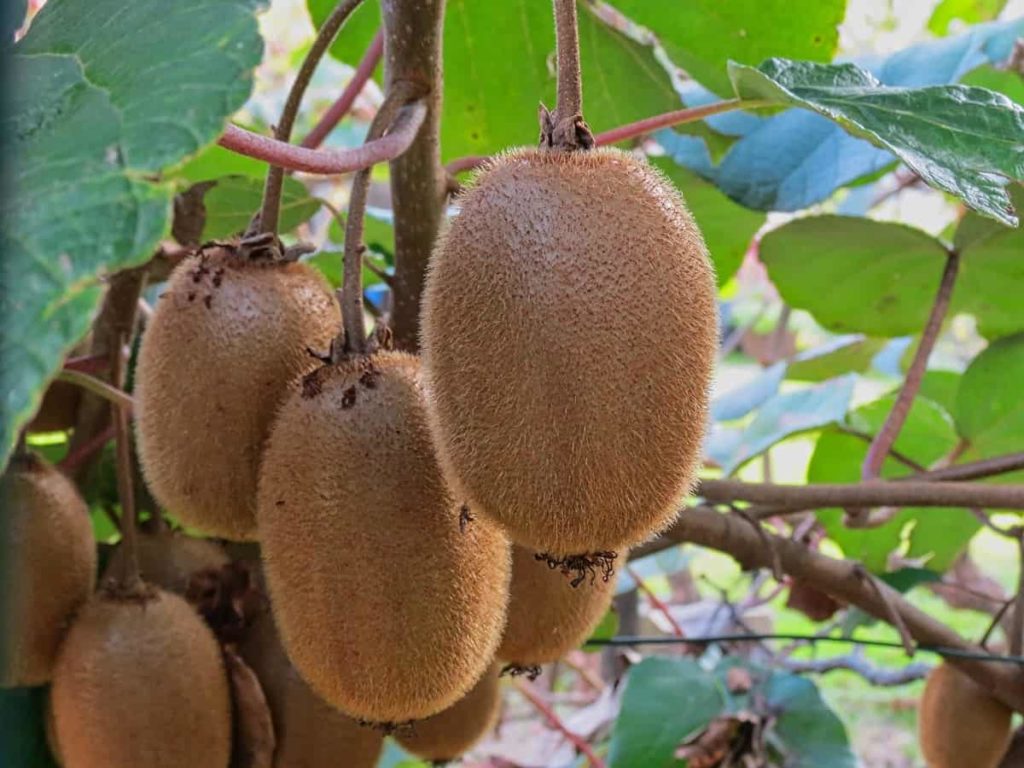Fertilizing Kiwi plants are an important part of their maintenance and will ensure a bumper crop of delicious fruits. Kiwi fruit grows rapidly, with luxuriant branches and leaves, and the results are many more quicks. It uses a lot of nutrients every year and needs soil to meet effective nutrients in time to meet its growth and development needs. Let’s check out the best fertilizer for Kiwi tree.

Production of Kiwi depends on the vegetative growth of the vines and requires an adequate quantity of manure and fertilizer for proper growth and development of the vines. You should test the soil before planting the Kiwi that you will get accurate information about the deficiency of fertilizer in the soil as the quantity of fertilizer, we are applying depends on soil type, weather condition, and age of vines.
Some soil conditions can cause problems that resemble nutrient deficiencies but are caused by other problems. For example, if your soil pH is too high, Kiwi plants can show signs of nutrient deficiency, such as yellowing and dropping leaves. Applying fertilizer in this situation will not solve the problem. For this reason, it is important to get a complete soil analysis of the level of nutrients as well as soil pH before fertilizing Kiwi plants.
Kiwi fruit plants need fertilizer in plantation and establishment years. Kiwi fruit plants are vigorous and they are needed more nitrogen (N) to help older plants grow. Plants with nitrogen deficiency will develop poorly and older leaves that are yellow-green or yellow compared to younger leaves. Depending on the type of fertilizer products, there are different application methods to ensure the maximum availability of nitrogen to plants.
Non-organic granules are often applied in equal parts (divisions) in spring and summer to ensure maximum performance of plant use and minimize the risk of salt pressure to plants. Liquid fertilizer is generally available to plants relatively quickly but it can also go beyond the skin root area. So, for liquid fertilizers, divide the total amount of N into smaller, more frequent uses, such as weekly.
In case you miss this: Kiwifruit Growing Tips, Ideas, Techniques, Secretes

Best fertilizer for Kiwi tree
Homemade fertilizers for Kiwi
- Coffee grounds – Brewed coffee contains good quantities of potassium and magnesium which are building blocks for plant growth.
- Epsom salt – Epsom salt is used on fruit trees to help them get bigger, sweeter, and more fruits.
Compost manure for Kiwi
Manure
Kiwi grows best in fertile, well-drained, slightly acid soils that are rich in organic matter. Apply the recommended quantity of farmyard manure (20e kg per plant) around the route zone of Kiwi plants. Mixing it lightly with the soil below will keep it from blowing away and ensure it reaches the roots.
Manures must be applied around plants in winter (January to February) every year before the plant start budding. The plant should be properly watered after applying fertilizer. To properly fertilize your Kiwi plant, water the base of the plant at least one to two days before the first fertilizer or manure is used.
Green Manure
If the soil is low in organic content, grow green manure crops or spread waste of plants before planting Kiwi and increasing organic material in the soil.
Vermicompost
If you just want to add organic fertilizer then apply two to four handfuls of any heavy organic fertilizer once every 45 days. You can use the Vermicompost for this purpose.
In case you miss this: Growing Kiwifruit At Home – A Full Planting Guide

Organic fertilizers for Kiwi
- Organic sources include cattle (0.6–0.4–0.5) and horse manure (0.7–0.25–0.6), yard debris compost (1–0.2–0.6), cottonseed meal (6–7–2), feather meal (12–0-0), bone meal (2–15-0) and fish emulsion (3–1–1).
- Kiwis like to fertilize with more balanced fertilizers like a fish meal in nitrogen every spring. Spread fertilizer throughout the vineyard area to feed the Kiwi root system.
- Cottonseed food improves soil structure, helps in making essential humic acids for proper plant growth and health.
- Soybean meal is that it is high in nitrogen as organic fertilizer often reaches 7%. Soybean meal has a common analysis of 7-1.5-1 (N, P, K) and is naturally a slow-release fertilizer. The common use is 100 square feet per 1 to 2 pounds of the garden. Fertilize Kiwi plants with soybean meal in spring.
- Bone meal is particularly good for better root growth and increased production. Naturally increases plant growth.
Natural fertilizers for Kiwi
- A 2 to 3-foot circle around the Kiwi plants with straw, manure, or other organic materials helps to preserve the moisture and helps keep the weeds down.
Liquid fertilizers for Kiwi
Compost tea
Compost tea is a good overall plant health booster and healthy plants are better able to resist pests and diseases. Good tea improves soil health. Healthy soils are less likely to lich nutrients outside plant root areas.
Fish emulsia
The fish emulsion contains burn-free nitrogen along with phosphorus and other basic nutrients of potassium. An excessive quantity of fish emulsion can burn plants and affect their growth. As long as you are careful, fish fertilizer is a light fertilizer that can be used in moderation, at almost any stage of plant growth.
Commercial fertilizers for Kiwi
NPK ratio
An all-purpose 10-10-10 fertilizer is good for Kiwi. You can use granular or liquid fertilizer but be careful not to cause the plant to burn. It is very important to give water after any fertilizer. A formulated citrus and Avocado food are recommended for fertilizing Kiwi plants.
In case you miss this: How to Start a Fruit Garden from Scratch

You can also choose to use a high nitrogen fertilizer containing trace elements. The best way to know which formula to use by taking a soil test is to get it done. It will tell you what elements your soil may lack and therefore need to be added. Nitrogen is always needed in early spring as the plant is sprouting again. Ammonium nitrate and urea are prescribed for the added nitrogen.
Kiwi fertilizer schedule
- In the year of the plantation, apply no more than 12 grams of nitrogen per month. The rate of product to apply will vary in terms of the percentage of nitrogen in products.
- Divide the fertilizer products in the area around the trunk 6 to 12 inches from the base of the trunk. There should be good soil moisture when plants are fertilized. First, irrigate, wait for a day or two, then fertilize or fertilize after a good rainfall.
- Do not compost young plants with liquid or granular forms of nitrogen at the end of July. Fertilize in the third and fourth years with a total rate of 1.7 kg or 2.5 kg nitrogen per acre, divided into three applications (every other month from late March to the end of July).
- In the fifth year, apply 2.5 kg nitrogen per acre using similar methods and times. In subsequent years, apply about 311 grams of ammonium nitrate, 28 grams of 0-46-0, and 450 grams of potassium sulfate per plant. Periodic applications of dolomitic limestone may be required to maintain pH in the appropriate limit (5.0-6.5) and supply magnesium to plants. Kiwi fruit needs about 680 grams of magnesium sulfate equivalent per plant after beginning fruit.
- After 5 years the same amount of farmyard manure and NPK after the year as described. For vines over the age of 6 use 45 to 89 kg nitrogen per acre annually, depending on the cultivar or the vine. Divide the total nitrogen rate by applying two-thirds (early shoot growth) in March and then the last third in May or June (fruit set and early fruit growth).
In case you miss this: Top 10 Fruits to Grow on the Terrace

- Irrigate a day or two before fertilizing, until there is good rainfall, and then irrigate again after fertilizing. Male vines may need an additional 4.5 to 12 kg of nitrogen after about two to three weeks of pruning to support the huge volume of shoot growth that occurs later.
- You can substitute liquid fertilizer applied through an irrigation system for dry fertilizer. When applying liquid fertilizer containing nitrogen, apply the same total rate, divide it into applications with more than 4.5 grams of nitrogen per application during the same period.
- High rates of liquid nitrogen (9 kg per application) have injured roots on light soil due to high concentrations of salt.
- Avoid the use of fertilizer blends and potassium (K) at high levels unless these nutrients are required based on soil. If so, avoid products that are high in potassium chloride as high levels of chloride in Kiwi fruit are toxic.
- If soil levels indicate that the level is inadequate, apply any essential P, K, and Magnesium fertilizers by broadcasting to the area lined up under the vine canopy at the end of winter. Essential micronutrients can be applied to the leaves.
How to fertilize Kiwi in pots
The Kiwis will actively grow once they are established and will need fertilization. But the roots are sensitive and can burn if you use more fertilizers. According to the label instructions, the use of balanced fertilizers like 16-16-16 will be more than sufficient, thrice a year. Otherwise, you can use soybean meal.
Add organic fertilizers like bone meal and blood meal or well-composted manure in the recommended quantity of manufacturer. Mix well with the shovel. Mulch to preserve soil moisture and reduce weeds. Mix to feed mulch vines with aged compost or commercial organic planting mix. Apply a balanced fertilizer in early spring as growth begins. Feed the vines with a dilute solution of fish emulsion or kelp meal during the growing season.
In case you miss this: Top 30 Quick Growing Fruits In Containers/Pots

Commonly asked questions about fertilizers for Kiwi
Why is my Kiwi not bearing fruit?
If your Kiwi is not blooming, it can be due to insufficient sunlight, more dry soil, water-filled soil, or insufficient nutrients in the soil.
Why is my Kiwi plant dying?
Symptoms of drought stress in the Kiwi include bending leaves that turn brown on the edges, leading to complete defoliation and plant death. Dehydration can also reduce the number of flowers, reduce fruit size and lack of fruits.
- Flower Garden Designs and Layouts for Beginners
- Planting and Spacing Techniques in Papaya: A Beginner’s Guide
- Growing Gold: Essential Techniques for Planting Pineapples
- How to Make Kalanchoe Plant Bushy: Home Remedies and Solutions
- 11 Reasons Why Your Gardenia is Not Blooming: Home Remedies and Solutions
- Eco Elegance: The Guide to Designing a Drought-Tolerant Landscape
- Gardening on a Slope: Strategies for Hillside Landscaping
- Nourish and Flourish: Top Organic Mulches for Thriving House Plants
- Everything You Want to Know about Indian Mogra Flower: Discover Uses and Growing
- Green Thumb Success: Expert Tips for Cultivating Greenhouse Pumpkins All Year Round
- Maximize Growth & Flavor: The Ultimate Guide to Companion Planting in Herb Gardens
- How to Control Rhododendron Problems Naturally: Home Remedies and Organic Ways to Fix Them
- Natural Magic: The Remarkable Benefits of Cinnamon for Plants
- Best Steps to Revive Dying Tulip with Natural and Organic Treatment
- 10 Reasons Why Your Angel Trumpet is Not Blooming: Remedies and Treatment
- How to Fix Periwinkle Leaf and Flower-Related Problems: Natural Remedies and Solutions
- How to Fix Zinnias Leaf and Flower Problems: Discover Natural and Home Remedies
- Organic Steps to Induce Lemon Tree Flowers: A Comprehensive Guide
- Bloom Booster: Crafting the Perfect Homemade Bougainvillea Fertilizer
- Optimizing Growth: A Guide to Applying NPK Fertilizer for Potted Plants
- 10 Best Homemade Fertilizers for Rubber Plant: DIY Recipes and Application Method
- How to Boost Female Pumpkin Flowers: Effective Steps for More Flowers and High Yields
- Transform Your Indoor Garden: Top Benefits of Pink Salt for Houseplants
- 10 Best Homemade Fertilizers for Peacock Plants (Calathea): Easy DIY Guide
- Unlock Blooms: 9 Reasons Why Your Potted Chrysanthemum is Not Blooming
- 8 Reasons Why Your Potted Hibiscus is Not Blooming: Fix it with Simple Solutions
- Unlock Blooms: 9 Key Reasons Your Potted Frangipani Won’t Flower
- 10 Reasons Why Is My Ice Plant Not Blooming: Remedies and Treatment
- 10 Reasons Why My Potted Hydrangea Not Blooming: Treatment and Remedies
- 10 Reasons Why is My Wisteria Not Blooming: Remedies and Treatment
- 10 Reasons Why is My Goldfish Plant Not Blooming: Remedies and Treatment
- Maximize Your Space: Ultimate Guide to Balcony Gardening with Grow Bags
- 10 Reasons Why Your Iris is Not Blooming: Remedies and Treatment
- 10 Reasons Why Your Anthurium Plant is Not Blooming: Treatment and Remedies
- 10 Reasons Why Your Aquaponic Plants Are Not Flowering: Remedies and Treatment
- 10 Reasons Why Your Agapanthus is Not Flowering: Remedies and Treatment